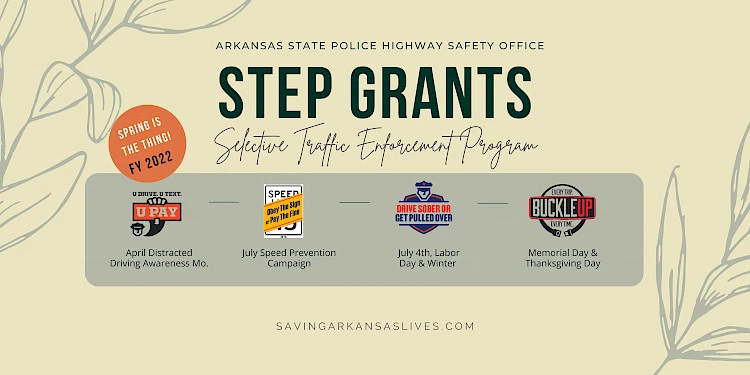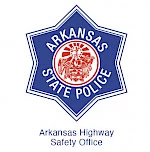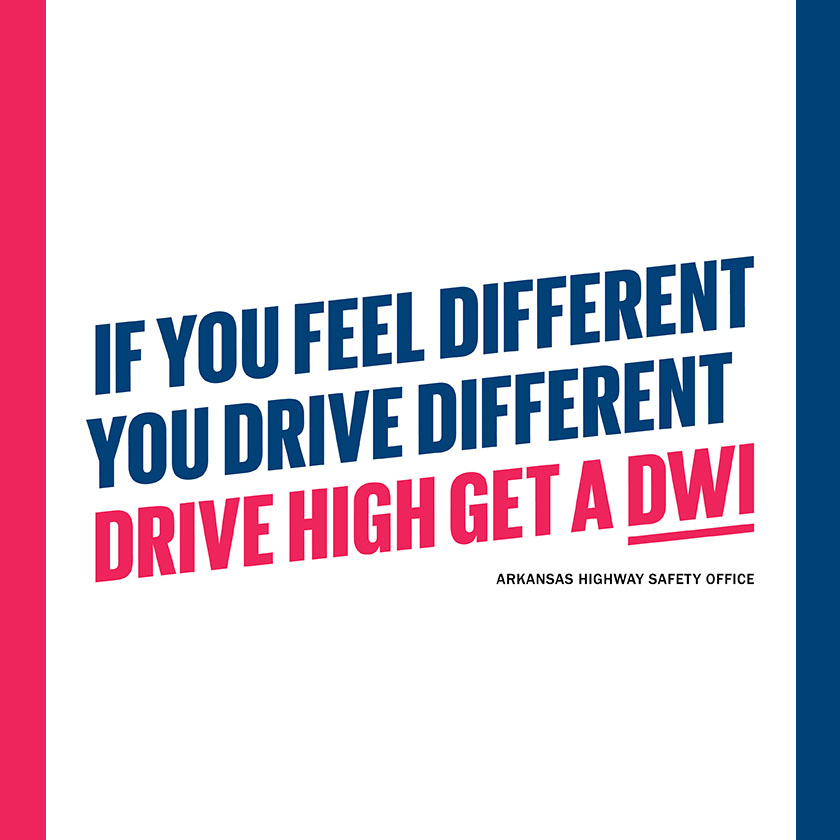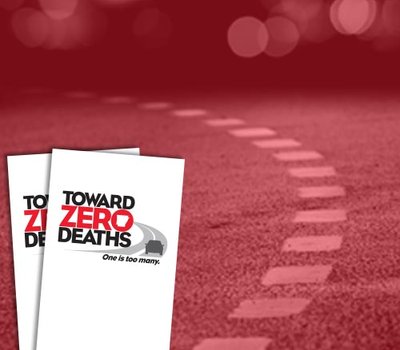Grants
Arkansas Highway Safety Office
eGrants: 21+ Frequently Asked Questions

The Arkansas Highway Safety Office (AHSO) receives funds annually from the National Highway Traffic Safety Administration (NHTSA) to promote roadway safety initiatives within the State of Arkansas.
The AHSO each year, develops an Arkansas Highway Safety Plan (AHSP) of countermeasures designed to reduce crash fatalities, serious injuries and economic loss using evidence-based strategies to create safer roadways for Arkansans.
The mission of the Arkansas State Police Highway Safety Office is to educate the motoring public on traffgic safety, support and facilitate the implementation of programs that reduce crashes, injuries and fatalities on Arkansas roadways.
With that in mind, the AHSO solicits applications for highway safety grant projects intended to support the mission to combat the number and severity of traffic crashes by developing and supporting educational, enforcement, and engineering programs. The grant programs address occupant protection and child passenger safety, impaired driving, motorcycle safety, pedestrian, bicycle safety and driver education programs.
NEW
GETTING STARTED
- What is an AHSO STEP Grant?
- Who can apply to receive a STEP Grant?
- Where do I go to find out more about how to apply?
- Where is the Registration Tutorial Video?
- Where is the Sub-Grantee Video?
- How does AHSO decide what programs will be funded?
- How can I find out if there is available grant money?
READY TO APPLY?
WORKING THE APPLICATION
- Do I need more than one quote for equipment upload?
- Do we submit the single page of the policy manual that refers to seat belt use or the entire chapter that covers that?
- What items should go in the Equipment line?
REIMBURSEMENTS
- What is meant by “cost reimbursement” grant funding?
- What costs are eligible for reimbursement?
- What documents would be considered “supporting documentation” for cost reimbursement?
COSTS & SUPPORTING DOCUMENTS
- How are “actual costs” different from the “budget costs” identified in the grant application?
- Does a separate account to track costs associated with the grant activity need to be established?
- What should I do if I can’t meet the deadline because I’m missing supporting documents?
- Do I need to submit a cost statement if there were no costs incurred for the reporting period?
- Who should I contact if I have financial questions regarding our grant?
- What’s a work statement as to STEP & Mini STEP
WHEN GRANT PROCESS STARTS & WHY
- Blog: STEP Grants What Are They And Who Can Apply
- We added 3 Mobilizations for FY22 that center around “Impaired Driving” holidays at the suggestion of some of our projects (see we listen).
- We doubled the length of the Speed Enforcement Mobilization.
- Here's the link to the AHSO Egrants Website: http://ahsoegrants.asp.arkansas.gov
The AHSO STEP Grant program includes increased or stepped-up enforcement, coupled with highly visible publicity administered by Arkansas Highway Safety Office funded by NHTSA as cost-reimbursable grants available to provide:
- Overtime Enforcement
- Traffic-related Safety Equipment (Radars, PBTs, Portable Speed Signs, Dash Cameras, etc.)
- Child Safety Seats
Blog: STEP Grants What Are They And Who Can Apply | Learn More About AHSO STEP Grants, click here.
3. Who can apply to receive an AHSO STEP Grant?
Arkansas Law Enforcement Agencies may apply for an AHSO STEP Grant.
4. Where do I go to find out more about how to apply for an Arkansas Highway Safety Office eGrant?
Click here to go to a separate website for Arkansas eGrants through the Highway Safety Office or visit here: http://ahsoegrants.asp.arkansas.gov
5. Where is the AHSO eGrant Registration Tutorial Video
Click here to go to the Arkansas Highway Safety Office Egrants website.
6. Where is the AHSO eGrant Sub-Grantee Video
Click here to go to the Arkansas Highway Safety Office Egrants website.
7. Question: How does AHSO decide what programs will be funded?
Answer: The annual process for deciding what projects will receive federal traffic safety funding starts with a thorough analysis of the most recent Arkansas traffic crash data that is coordinated by the AHSO using FARS and eCrash data. Emphasis is placed on the three highest priority traffic safety performance measures for states:
- Number of traffic crash fatalities
- Number of suspected serious injuries
- Fatalities per 100 million vehicle miles traveled
Multi-year data analysis provides insight into the most pressing problems associated with fatal and serious injury crashes. Crash data is the basis for identifying the why, when, where, and how these crashes occur. Arkansas’ annual seat belt observation survey conducted by partner University of Fayetteville and similar studies also assist with problem identification.
Along with data analysis, the AHSO works with partners and stakeholders to generate input, ideas, and suggestions for possible programming. This includes the Strategic Highway Safety Action Plan action teams (produced every five years), regional Traffic Safety Networks, and grantees.
AHSO directs resources toward countermeasures that have demonstrated research-based success at reducing fatalities and serious injuries. These behavior-based countermeasures are most likely to increase seat belt and child safety seat use, reduce impaired driving as well as compliance with other life-saving roadway safety laws.
Under the Fixing America’s Surface Transportation (FAST) Act, states receive federal funding to support national and state priorities for reducing roadway deaths and injuries. Arkansas also qualifies for funding for occupant protection, impaired driving, state traffic safety information system improvements, motorcyclist safety, and nonmotorized safety (pedestrian and bicycle).
8. Question: How can I find out if there is available grant money?
Answer: Check the AHSO staff listing for a listing of staff and their program area. Match the traffic or roadway safety issue with the program area and send the AHSO staff person an email.
9. Question: Where do I start an AHSO grant application?
Answer: To start the AHSO grant application, go to the AHSO Egrants Website: http://ahsoegrants.asp.arkansas.gov
10. Question: Do I need more than one quote for equipment upload?
Answer: No. One quote justifying the request amount is sufficient for the application. If the project is awarded, formal quotes may be required.
11. Question: Do we submit the single page of the policy manual that refers to seat belt use or the entire chapter that covers that?
Answer: A single page is enough as long as it is discernable that the policy is for your agency and has the complete stance on seat belt use.
12. Question: What items should go in the Equipment line?
Answer: Individual items over $500 per item and component necessary for use are considered equipment. Ex. 1 10,000 educational brochures costs $900 to print. Each brochure is $0.09. The expense is an OPERATING, not equipment, expense. Ex. 2 A computer tower costs $600. The monitor costs $200. BOTH items go into the equipment line because the items function as a whole.
13. Question: What is meant by "cost reimbursement" grant funding?
Answer: Reimbursement means grant-funded agencies must first expend their own money for activities identified in the grant application. Agencies will then be reimbursed by AHSO for actual costs incurred.
14. Question: What costs are eligible for reimbursement?
Answer: Only costs identified in the grant application budget are eligible for reimbursement. Support documentation showing actual costs expended must be included when submitting a quarterly or monthly financial report for reimbursement.
15. Question: What documents would be considered "supporting documentation" for cost reimbursement?
Answer: Copies of invoices, officer dailies, checks for contractual payments or equipment purchases, and account or fund expenditure reports, are examples of supporting documentation.
16. Question: How are "actual costs" different from the "budget costs" identified in the grant application?
Answer: Budgeted costs that are identified in the application are projections based on expected activity. Costs eligible for reimbursement are the actual expenses incurred to support grant activity. As an example, an equipment cost included in the budget may be a projection based on current valuations. However, the actual cost may be different at the time of the purchase. The actual cost paid is the amount that can be reimbursed.
17. Question: Does a separate account to track costs associated with the grant activity need to be established?
Answer: A means of separating expenses for grant activity from general or other agency costs must be established. Depending on the agency accounting procedures, this can be accomplished through a separate account, a separate fund, or through specifically identified budget lines.
18. Question: What should I do if I can't meet the deadline because I'm missing supporting documents?
Answer: Cost statements need to be submitted by the due dates. Submitting a cost statement without support documentation will prevent a delinquency notice from being issued. However a reimbursement will not be made until appropriate documentation is identified and submitted. It may be necessary to contact the AHSO Grant Coordinator of the specific grant to determine if substitute documentation will suffice. The cost statement should contain a notice that support documentation will follow, or that contact with our office will be made by your financial officer.
19. Question: Do I need to submit a cost statement if there were no costs incurred for the reporting period?
Answer: Yes. Cost statements should indicate $0 costs and be submitted by the due date.
20. Question: Who should I contact if I have financial questions regarding our grant?
Answer: The program coordinator in your grant approval letter should be able to answer your questions.
21. What’s a work statement as to STEP & Mini STEP
Work statements (the part of your agreement that outlines the basics of what you are agreeing to with the agreement and what AHSO is agreeing to with the contract) and we are waiting for that draft to be approved so our Program Managers have a template to use to customize it to each agencies agreement.
22. Why our grant process starts October 1st?
The reason our grant process starts October 1st, is that since this is a NHTSA grant we have to use a Federal Fiscal year for the agreements to coincide with their budget cycle.
23. What time of day, can we conduct STEP enforcement?
-
- Seat belt enforcement (from 6:00 a.m. until 9:00 p.m.) will emphasize enforcement of seat belt and child restraint laws.
- Speed enforcement (from 6:00 a.m. until 9:00 p.m.) will emphasize speed violations.
- Distracted Driving enforcement (from 6:00 a.m. to 9:00 p.m.) will emphasize distracted driving violations.
- DWI/DUI enforcement will emphasize enforcement of DWI/DUI laws and may be worked anytime day or night any day of the week. (NOTE: this is a change from previous STEP agreements) Participating officers are expected to average two vehicle stops per hour when not actively processing a DWI arrest during DWI enforcement.
- During enforcement mobilizations time restrictions DO NOT apply and Seat Belt, Speed and Distracted Driving may be enforced day or night.
For Grant Recipients Only
Understanding Your Grant Status
Go to the grant website and login, under the My Task list you will see your FY22 agreement and under that status if it says “Sub-Grantee Signatures Required” that means that you have not submitted the agreement yet. Refer back to the instructions which I will list below and follow all of the instructions to submit the agreement.
If the status is: “Agreement Signature Verification”, “GR Signature Required” or “Agreement Executed” then you have submitted your agreement back to AHSO. “Agreement Executed” means that our Colonel has signed off on the agreement and it is final, “GR Signature Required” means it is waiting for the Colonel to sign it and “Agreement Signature Verification” means it is with our Administrator who will check to make sure everything is complete on the agreement that is uploaded before sending it to the Colonel.
If the status is: “Agreement in Process” that means that you have not submitted your agreement to AHSO yet. Please complete the application as soon as you can and submit it to AHSO. We will review it and try to get your agreement completed before the next Mobilization.
If the status is: “Application in Review” then AHSO has received the application and we are in the process of reviewing it and
I have been awarded a STEP/Mini-STEP Grant. Do you have available material to publicize the campaigns/events?
Yes. The NHTSA traffic safety marketing website provides press release samples, fact sheets, logos and other information: (https://www.trafficsafetymarketing.gov/) They offer this material so that you have something to work with for Public Information and Education materials for all upcoming mobilizations.
Other Resources
NHTSA Printable Planner 2022-2024
FY 2022 Upcoming Event/Awareness Campaigns
NHTSA's Traffic Safety Marketing
Program Managers
Michael Catanach, Program Manager, STEPS, Egrants, Occupant Protection
michael.catanach@asp.arkansas.gov
Chip Payne, Program Manager, STEPS, Impaired Driving
Cindy Grisham, Program Manager, eCrash, Traffic & FARS Team Manager
cindy.grisham@asp.arkansas.gov
Colby Little, Program Manager, Pedestrian/Bike, STEPS
colby.little@asp.arkansas.gov
Earma Brown, Program Manager, Public Information/Education
Arkansas State Police Highway Safety Office



